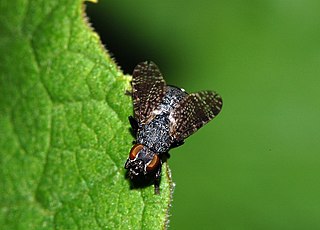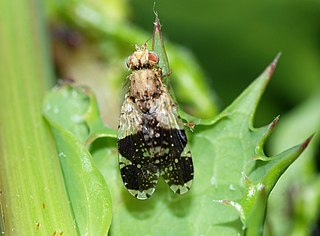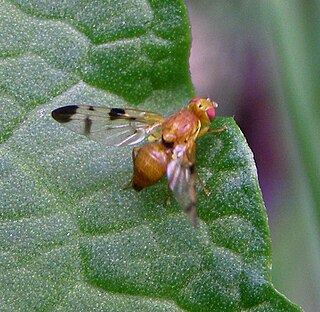
The Tephritidae are one of two fly families referred to as fruit flies, the other family being the Drosophilidae. The family Tephritidae does not include the biological model organisms of the genus Drosophila, which is often called the "common fruit fly". Nearly 5,000 described species of tephritid fruit fly are categorized in almost 500 genera of the Tephritidae. Description, recategorization, and genetic analyses are constantly changing the taxonomy of this family. To distinguish them from the Drosophilidae, the Tephritidae are sometimes called peacock flies, in reference to their elaborate and colorful markings. The name comes from the Greek τεφρος, tephros, meaning "ash grey". They are found in all the biogeographic realms.

Helina is a very large genus from the fly family Muscidae.

Dolichopodidae, the long-legged flies, are a large, cosmopolitan family of true flies with more than 7,000 described species in about 230 genera. The genus Dolichopus is the most speciose, with some 600 species.

The Lonchaeidae are a family of acalyptrate flies commonly known as lance flies. About 500 described species are placed into 9 genera. These are generally small but robustly built flies with blue-black or metallic bodies. They are found, mainly in wooded areas, throughout the world with the exception of polar regions and New Zealand.

The Platystomatidae are a distinctive family of flies (Diptera) in the superfamily Tephritoidea.

The Pyrgotidae are an unusual family of flies (Diptera), one of only two families of Cyclorrhapha that lack ocelli. Most species are "picture-winged", as is typical among the Tephritoidea, but unlike other tephritoids, they are endoparasitoids; the females pursue scarab beetles in flight, laying an egg on the beetle's back under the elytra where the beetle cannot reach it. The egg hatches and the fly larva enters the body cavity of the beetle, feeding and eventually killing the host before pupating. In the United States, some species of Pyrgota and Sphecomyiella can be quite common in areas where their host beetles are abundant. Like their host beetles, these flies are primarily nocturnal, and are often attracted to artificial lights.

Myiopharus is a genus of flies in the family Tachinidae.

Senostoma is a genus of parasitoid tachinid flies in the family Tachinidae. Endemic to Australasia, the flies are medium-sized, bristly, and long-legged.
Lixophaga is a genus of flies in the family Tachinidae.
Baryplegma is a genus of tephritid or fruit flies in the family Tephritidae.

Neotephritis is a genus of tephritid or fruit flies in the family Tephritidae.
Platensina is a genus of tephritid or fruit flies in the family Tephritidae.

Tephritis is a genus of flies. It contains around 170 described species, making it the sixth largest genus in the family Tephritidae. Many more undescribed species are known from specimen collections. Tephritis occur throughout much of the world, but most are Palearctic. They can be found in a wide range of climate types, from hot semidesert to tundra. Most species inhabit the inflorescences of plants from several tribes in the family Asteraceae, and a few species cause galls to form.

Trypeta is a genus of tephritid, or fruit flies in the family Tephritidae.

Trupanea is a genus of tephritid or fruit flies in the family Tephritidae.

Monochamus scutellatus, commonly known as the white-spotted sawyer or spruce sawyer or spruce bug, is a common wood-boring beetle found throughout North America. It is a species native to North America.

Acrotaeniini is a tribe of tephritid or fruit flies in the family Tephritidae.

Tephritini is a tribe of fruit flies in the family Tephritidae. There are about 12 genera and at least 40 described species in Tephritini.
Euplatypus parallelus, previously known as Platypus parallelus, is a species of ambrosia beetle in the weevil family Curculionidae. The adults and larvae form galleries in various species of tree and logs. It is native to Central and South America but has spread globally, is present in Africa and is well established in tropical Asia.














